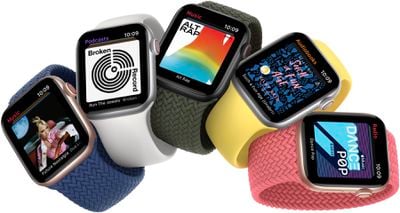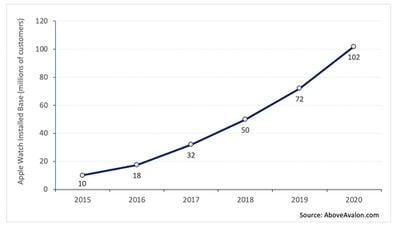More than 100 million people globally now own an Apple Watch, an adoption milestone Apple surpassed this December, according to estimated figures compiled by Avalon's Neil Cybart.

Apple launched its smartwatch in April 2015. Since that time, Cybart's analysis suggests the growth trajectory of the device's user base has been neither constant nor steady, with the 30 million new people that began wearing an Apple Watch in 2020 nearly exceeding the adoption rate of users throughout 2015-2017.
Cybart also looked at Apple Watch as a percentage of the iPhone user base, which he considered a good proxy for the size of the potential Apple Watch market, given that an iPhone is required to use the watch (with a few exceptions, such as Family Setup). Based on his data, Cybart believes that around 10% of iPhone users worldwide wore an Apple Watch by the end of 2020.

Cybart also looked at U.S. adoption of Apple Watch specifically:
Since the U.S. has been an Apple Watch stronghold for years, adoption in the country has trended materially high in comparison to global figures. At the end of 2020, approximately 35% of iPhone users in the U.S. were wearing an Apple Watch. This is a shockingly strong adoption rate that should serve as a wake-up call to Apple competitors interested in the wearables space. Apple Watch turned Fitbit from a household name as the wearables industry leader into a company that will eventually be viewed as an asterisk when the wearables story is retold to future generations.
Overall, Cybart believes the figures show that Apple Watch is Apple's fourth-largest installed base behind the iPhone, iPad, and Mac, and at the current sales trajectory will surpass the Mac installed base in 2022.

Looking further ahead, Cybart believes there is "nothing stopping much higher adoption over time," and predicts that if just 35% of iPhone users around the world one day wear an Apple Watch – the same adoption percentage found in the U.S. – the Apple Watch installed base would exceed 350 million people, which is two and a half times higher than the current user base.
Cybart suggests that Apple Watch could make even more headway if Apple opened it up to non-iPhone users, and suggests that the device's future roles in Apple's product line could include: Expanded identity authentication uses beyond Macs, and most recently, iPhones; advances in health monitoring; and as an ideal location on the body to offload resources linked to face-based technologies like smart glasses.
Apple has never disclosed official sales figures for Apple Watch, and instead lumps the device into its Wearables, Home, and Accessories category (previously known as the "Other" category), which also includes HomePod mini, and all of the AirPods models, including the AirPods Max.
However, based on Apple's last earning's report, the category brought in record revenue in the first fiscal quarter of 2021 (fourth calendar quarter), hitting $13 billion, up from $10 billion in the year-ago quarter, reflecting 30% growth.
























